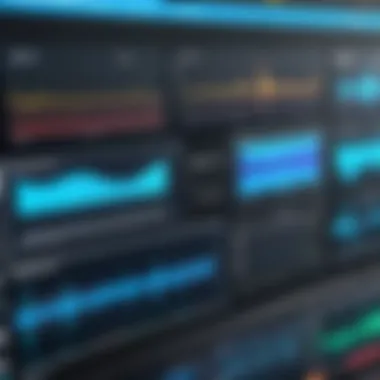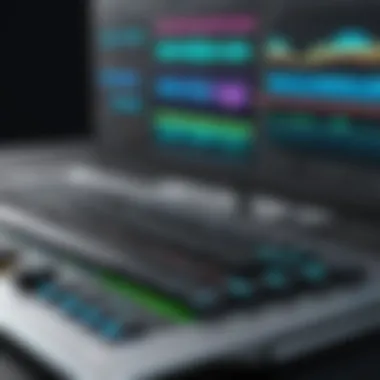Exploring the Best Audio Recording Software Options


Intro
The evolving landscape of audio recording software presents unique challenges and opportunities for professionals in sound engineering and music production. As technological advancements continue to emerge, understanding the core features and capabilities of various software options becomes essential. This guide navigates through the intricate domain of audio recording software, shedding light on the elements that differentiate superior tools from their competitors.
Whether you are a seasoned audio engineer or an aspiring producer, selecting the right software can significantly influence your workflow and the quality of your output. Thus, a comprehensive exploration of features, performance metrics, and industry insights is pertinent for informed decision-making.
Features Overview
Key Specifications
In evaluating audio recording software, several key specifications must be considered. These specifications include:
- Audio Quality: Sample rate and bit depth are critical. Higher values typically yield better sound fidelity.
- Compatibility: Supports various operating systems and hardware is essential for seamless integration into your existing setup.
- Plugin Support: A robust selection of plugins can expand functionality. Software compatible with VST, AU, and AAX formats is often preferable.
- User Interface: Intuitive and customizable interfaces improve user experience. Look for clean layouts that enhance productivity.
- Number of Tracks: The capability to handle multiple tracks simultaneously varies across software.
Unique Selling Points
When assessing software, some features stand out as unique selling points:
- Cloud Integration: Some modern software allows for cloud backing, facilitating easy access and collaboration.
- Real-time Collaboration: Tools like Avid Pro Tools enable multiple users to work on projects in real-time, essential for remote working environments.
- Advanced Editing Features: Software with capabilities for MIDI editing offers a comprehensive approach to sound design.
- Support and Community: An active user community provides support and resources, enhancing your learning and problem-solving experiences.
"Choosing the right audio recording software is not just about features. It encompasses usability, future-proofing, and support resources."
Performance Analysis
Benchmarking Results
Assessing performance through benchmarking is crucial. Metrics like latency, processing speed, and resource consumption can reveal much about software efficiency. High-performing audio software minimizes latency, allowing real-time recording without noticeable delay. Conducting side-by-side tests can yield valuable insights into which software handles large projects efficiently.
Real-world Scenarios
Consider the practical implications of your software choice in various scenarios:
- Music Production: Whether creating electronic music or recording live instruments, the software should handle each genre's specific requirements effectively.
- Post-Production: Software used in film post-production often requires advanced audio editing tools to synchronize sound with visuals.
- Live Recording: If you test software in a live setting, it should exhibit stability under pressure and handle various input sources seamlessly.
Analyzing performance in real-world conditions will guide you toward software that meets your specific needs effectively.
By navigating through these discussions, this guide offers a substantive foundation for evaluating and selecting audio recording software pertinent to your objectives.
Understanding Audio Recording Software
Audio recording software plays a crucial role in today's digital landscape. For many professionals in sound engineering, music production, and related fields, the right software can significantly enhance their workflow, creativity, and overall output quality. This is especially vital in an age where audio quality can make or break projects. The understanding of audio recording software encompasses its definition, purpose, and its relevance across various industries that utilize audio.
Definition and Purpose
Audio recording software refers to programs that enable users to capture, edit, and produce sound recordings. It serves multiple purposes, ranging from simple voice memos to complex music production. Most audio recording software includes a range of functionalities, such as multi-track recording, various editing tools, and mixing capabilities.
These programs allow users to manipulate audio tracks with precision. They may include features such as sound equalization, effects addition, and the ability to import various formats for compatibility with different devices. When professionals understand the definitions and core purposes of audio recording software, they can make better decisions tailored to their specific needs.


Importance in Various Industries
The significance of audio recording software transcends mere technical capability; it also has a profound impact on many industries. In the music industry, for example, software like Pro Tools and Ableton Live provides musicians with the tools to produce, mix, and master their tracks.
In the realm of broadcasting, journalists and content creators use audio software to create engaging stories through clear and edited sound bites. The film industry relies heavily on audio for soundtracks and dialogue editing, where programs like Adobe Audition are crucial. Similarly, podcasting has seen explosive growth, requiring robust audio solutions for recording and post-production.
Moreover, businesses are leveraging audio for advertising and training purposes. Creating high-quality audio content can enhance customer engagement and improve learning experiences.
The selection of appropriate audio recording software is critical for effectiveness in various industries. A well-chosen program leads to enhanced productivity and qualitative outcomes.
In summary, understanding audio recording software is fundamental for anyone involved in audio production, whether for music, broadcasting, film, or business applications. This knowledge enables professionals to navigate the complexities of sound engineering and utilize the right tools to achieve their goals.
Key Features of Good Audio Recording Software
When considering audio recording software, several key features can greatly influence the usability and overall quality of the recording experience. An understanding of these aspects is essential for IT professionals or enthusiasts aiming to find the right tool for their specific needs. Good audio recording software not only facilitates the task of capturing sound, but also enhances the post-production process significantly. This section will delve into the critical features that define effective audio recording solutions.
User Interface and Experience
A well-designed user interface is paramount in audio recording software. It directly affects how users interact with the program, which can influence productivity and creativity. The layout should be intuitive, allowing users to access essential tools without unnecessary navigation. A clean interface fosters an environment where professionals can focus on their projects rather than getting bogged down by complicated menus.
Considerability should also be given to the experience surrounding the software. Features like customizable layouts, keyboard shortcuts, and tooltips can streamline usability and reduce the learning curve for new users. Overall, a user-centric design can significantly elevate the recording experience, making it both efficient and enjoyable.
Multi-track Recording Capabilities
Multi-track recording is a crucial feature for any robust audio software. This allows users to record multiple audio sources simultaneously. Musicians, for example, can track vocals, guitars, and drums separately, enabling better control during mixing. In post-production, users can adjust levels and effects per track, enhancing the final output’s quality.
The ability to handle several layers of audio tracks also supports complex arrangements. This feature is vital for sound engineers and producers looking to create multi-dimensional soundscapes. Without effective multi-track capabilities, the software may limit creativity and complicate the workflow.
Editing and Mixing Tools
Editing and mixing are fundamental components of audio production. Good software should provide a wide range of editing tools. Functions like cutting, trimming, and splitting tracks must be precise and easy to use. Advanced features such as time-stretching and pitch-shifting tools can further empower users to manipulate audio creatively.
Mixing tools, including volume faders, equalizers, and effects processors, should be readily available. These tools not only improve sound quality but also allow for artistic expression. A comprehensive set of editing and mixing features can make or break the software’s appeal to a discerning audience.
File Format Support
In the ever-evolving landscape of audio recording, file format support is crucial. Different projects may require various audio formats. A reliable recording software should accommodate popular formats like WAV, MP3, AIFF, and others. This flexibility allows users to export and share work across diverse platforms and applications easily.
Additionally, compatibility with uncompressed formats is essential for professionals looking to maintain audio quality during production. Without extensive file format support, users might find themselves constrained, leading to potential compatibility issues down the line.
Integration with Other Tools
The ability to integrate seamlessly with other tools or software can enhance the recording experience significantly. Many professionals utilize multiple platforms for various aspects of production. Therefore, software that supports Plug-Ins, MIDI controllers, and external hardware can significantly streamline workflows.
Furthermore, integration capabilities with cloud-based services or collaboration tools can help users share projects effortlessly. This can be especially beneficial for those working in teams or remote settings.
Popular Audio Recording Software Options
When navigating the realm of audio recording software, it is essential to familiarize oneself with the most widely used options in the market. The effectiveness and reliability of audio production tools play a vital role in the quality of end products. Thus, having a solid understanding of popular audio recording software can aid professionals in making informed decisions that align with their specific needs.


Exploring different software options allows users to compare features, ease of use, and pricing. This analysis not only establishes benchmarks for performance but also facilitates discussions around user preferences and industry standards. A comprehensive review of these applications can highlight unique capabilities and potential shortfalls, assisting in streamlining the selection process.
Whether the focus lies on sound engineering, music production, or broadcasting, selecting appropriate software can enhance one's overall workflow. Understanding which solutions provide essential functionalities while maintaining user-friendliness is crucial for achieving timely and professional results.
Software Overview and Ratings
Software ratings are a prevalent method for gauging the effectiveness of audio recording applications. Reviews often derive from user experiences and can provide insight into performance and usability. Factors that play roles in these ratings include functionality, customer support, and compatibility with various operating systems.
Major platforms feature aggregated scores based on user feedback, allowing for quick assessments. This information is instrumental for professionals needing reliable and efficient tools, especially when budget constraints limit options. Additionally, industry-recognized publications often review software, providing frameworks for comparisons that can guide selections.
Software A: Features and Pricing
Software A, known for its user-friendly interface, offers a robust set of features aimed at both beginners and seasoned professionals. Key functionalities include multi-track recording, a variety of editing tools, and extensive format support. The pricing structure is tiered, catering to varying budgets with additional functionalities offered in higher-end packages.
One notable feature of Software A is its seamless integration with digital audio workstations. Users can enjoy the convenience of recording and editing within a single environment, enhancing workflow efficiency. Licensing options provide flexibility, allowing for both one-time purchases and subscription models. This adaptability makes Software A suitable for freelancers as well as larger studios.
Software B: Features and Pricing
Software B has gained traction among sound engineers for its advanced editing capabilities. The software includes features such as spectral editing, pitch correction, and real-time effects processing. These tools empower users to create high-quality recordings with precision.
In terms of pricing, Software B targets professionals willing to invest in quality. Although its initial cost may be higher, the long-term benefits of production value can justify the expense. Educational discounts are available, making it an attractive option for students aspiring to enter the industry.
Software C: Features and Pricing
Software C stands out with its cloud-based architecture, which offers unique advantages for collaboration. Animated by real-time collaboration tools, it allows multiple users to work on the same project simultaneously from various locations. This feature is particularly appealing for teams spread across different geographical areas.
Pricing for Software C includes a monthly subscription model, which can be economical for businesses that need flexibility. Users can try the software for free before fully committing, allowing potential customers to evaluate functionalities firsthand. Its cross-platform capabilities ensure access from different devices, thus enhancing user accessibility.
In summary, selecting suitable audio recording software is critical for achieving quality work. By understanding the various options available, professionals can better navigate their choices, tailoring their toolsets to fit industry demands and personal workflows.
Evaluating Performance and Usability
Evaluating the performance and usability of audio recording software is essential for professional settings. For those in sound engineering, music production, or broadcasting, it directly affects the quality of output and the efficiency of their workflow. Understanding how software performs under various conditions will help IT professionals decide if it fits their needs. Furthermore, user experience is critical, as the complexity of software can impact productivity.
The ability to evaluate performance involves examining key elements such as system requirements and support structures. A software that tasks a machine beyond its capabilities can lead to lagging recordings and frustration. In addition, user support and community engagement can influence how quickly and effectively someone can resolve the challenges that arise when using new software. Good software should also be intuitive, allowing users to focus on their creative work rather than struggling with technical details.
System Requirements
When selecting audio recording software, system requirements play a crucial role in performance. Every software has minimum and recommended specifications, which can impact the user experience significantly. These requirements include the operating system, processor speed, RAM, and available storage.
- Processor: A powerful CPU can handle more tracks and effects, improving real-time processing.
- RAM: More memory permits smoother operations, especially when working with demanding projects.
- Storage: Fast drives, such as SSDs, ensure quicker load times and minimize latency.
It is important for professionals to match their hardware capabilities with the software they wish to use. If the software requires more resources than the available system can provide, it will lead to performance issues. Ensure to follow the recommendations provided by the software developers to avoid unnecessary complications.
User Support and Community
Another critical aspect of evaluating audio recording software is the level of user support and the presence of an active community. Reliable customer support can help users troubleshoot problems quickly, ensuring a smooth operation. Here are key considerations:


- Documentation: Comprehensive guides and user manuals provide clarity on features and usage.
- Forums and Community Involvement: Active communities like those found on Reddit provide invaluable insights and peer support. They help users share experiences, tips, and tricks regarding specific software.
- Responsive Support: The responsiveness of the support team can have a significant impact on user satisfaction. Fast replies to queries show commitment to their users.
Considerations for Choosing the Right Software
When selecting audio recording software, multiple factors come into play to ensure it meets the user’s specific needs. Understanding these considerations is essential for making an informed decision. Users may vary in their experience levels, equipment, and recording goals. Therefore, particular attention must be paid to unique attributes that can enhance the recording experience and the quality of output.
Skill Level of the User
The skill level of the user is a primary consideration when selecting software. Beginners may benefit from a user-friendly interface and basic features that simplify the recording process. More experienced users, however, might require advanced tools and customizable options that offer greater flexibility and control.
This disparity in needs influences the choice of software significantly. For instance, novices might find software like Audacity advantageous due to its straightforward design and comprehensive tutorials. Alternatively, seasoned professionals could favor more complex platforms like Pro Tools or Ableton Live, which deliver advanced functionality.
Some key points to keep in mind include:
- Ease of Use: Beginners should look for intuitive interfaces.
- Feature Depth: Advanced users might prioritize extensive editing and mixing capabilities.
- Learning Resources: Accessibility to tutorials and community support can make a huge difference.
In essence, understanding one’s own skill level can lead to selecting software that not only serves current needs but also provides room for growth.
Budget Constraints
Budget constraints are another critical factor in deciding on audio recording software. The market offers a spectrum of options ranging from free tools to high-end paid solutions. It is vital to assess what features are necessary and whether they justify the investment.
Several aspects of budgeting should be considered:
- Initial Costs: Evaluate the price of the software and any associated hardware.
- Subscription vs. One-Time Purchase: Some software, like Adobe Audition, requires a subscription model, while others like GarageBand might be a one-time purchase or free.
- Future Investments: Think about potential upgrades or additional plugins and whether they fit into the budget.
Choosing software strictly based on price alone can lead to compromises on quality or functionality. Rather, users must align their needs with financial practicalities to find a balanced approach.
Remember: Spending a bit more upfront on high-quality software can save costs on future upgrades and training, enhancing overall productivity!
Ultimately, careful consideration of skill level and budget can empower users to select audio recording software that complements their workflow and achieves desired results.
Future Trends in Audio Recording Software
Understanding future trends in audio recording software is essential for professionals looking to remain competitive in an ever-evolving industry. The rapid pace of technological advancements shapes how audio is captured, edited, and shared. Cloud-based solutions and AI and machine learning integration are two key areas that stand to significantly influence the future landscape.
By exploring these trends, users can discover how to leverage new tools and methodologies. Adaptation and understanding of these developments can lead to improved workflows and better sound production quality. The following sections will delve into these themes in greater depth, considering their benefits and practical implications for professionals in the field.
Cloud-Based Solutions
Cloud-based solutions represent a monumental shift in how audio recording is approached. The primary advantage of using the cloud is accessibility. Audio professionals can access their projects from anywhere, provided they have an internet connection. This flexibility allows for collaboration across geographical boundaries, facilitating a more connected workflow among team members.
In addition to collaboration, cloud-based recording software often includes robust storage capabilities, safeguarding projects against local hardware failures. For example, using services like Google Drive or Dropbox can enhance project management. The ability to share large files easily is another key benefit. Many established software providers have incorporated cloud functions, allowing real-time updates and edits, which traditionally required physical equipment.
However, reliance on cloud infrastructure introduces considerations regarding internet bandwidth and security. Users must ensure they choose reputable vendors with strong encryption standards to protect their data. As businesses increasingly integrate these solutions into daily operations, understanding the security implications becomes paramount.
AI and Machine Learning Integration
The integration of AI and machine learning technologies into audio recording software is beginning to change the production landscape dramatically. These tools can automate repetitive tasks, such as noise reduction, equalization, and volume leveling. By streamlining these processes, audio engineers can dedicate more time to creative aspects, rather than technical adjustments.
AI can provide intelligent suggestions based on previously analyzed sounds or project characteristics. For instance, when recording multiple instruments, AI tools can recommend optimal mixing settings or alerts about peaks in audio levels. This predictive capability enhances overall production efficiency.
Furthermore, machine learning algorithms work on understanding user preferences over time. As the software learns individual habits, it can offer personalized features that cater to specific workflows. Users may interact less with cumbersome interfaces and enjoy a more intuitive experience.
Nonetheless, the integration of AI brings about questions of creativity, ownership, and the need for human oversight. While machines can assist, they cannot replicate the nuanced decision-making that experienced audio professionals provide. Therefore, understanding how to effectively combine these new tools with traditional techniques remains a crucial skill.



